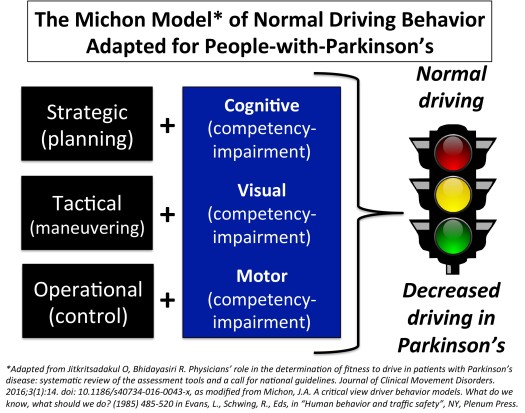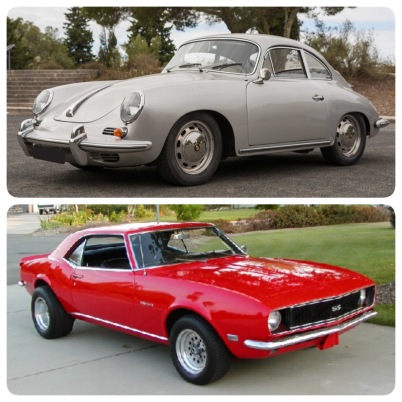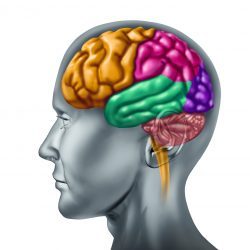“Have you ever noticed that anybody driving slower than you is an idiot, and anyone going faster than you is a maniac?” George Carlin

“The one thing that unites all human beings, regardless of age, gender, religion, economic status, or ethnic background, is that, deep down inside, we all believe that we are above-average drivers.” Dave Barry
Decision-making while driving: Below are some traffic signs that we might encounter in our usual driving pattern depending on where we live. When you think about decision-making you’re in your lane you’re driving down the road and you see signs like this, then what? You can see how it takes all three levels of driving competency to navigate successfully while driving a motor vehicle in a complex maneuver. Now add the complications of someone with Parkinson’s, you may need to re-think the entire situation. What this says is that when you’re driving a motor vehicle you’re trying to integrate many levels of sensory, motor and cortical function to the process. In Parkinson’s, we may have some sort of motor skill/task impairment, potentially mixed with a minor cognitive disorder, and further clouded by traditional drug therapy. Who makes the decision for the patient with Parkinson’s about being able to continue to drive? Not an easy answer.
“Some beautiful paths can’t be discovered without getting lost.” Erol Ozan
Possible problems that could occur while driving with Parkinson’s: The control or operational level of driving a car can be influenced by motor defects experienced by many with Parkinson’s, including rigidity, tremor, bradykinesia and dyskinesia. Futhermore, non-motor deficits could impair both route planning, strategic and tactical levels, and these would include cognitive decline, neuropsychiatric symptoms and/or visual impairment. And on top of that in the elderly population, many people with Parkinson’s have additional co-morbidity that could also contribute to diminish our ability to drive a motor vehicle. Thinking about just one aspect, slowness in cognitive function, the inability to make a decision quickly could lead to poor performance time and might affect driving in someone with Parkinson’s. Alternatively, you may have none of these problems and will be driving for many more years. But as we all start to exhibit signs and symptoms of motor and non-motor deficits, this will eventually become an important issue for each of us to deal with at some point in time.
“Always focus on the front windshield and not the review mirror.” Colin Powell
What are some criteria for determining our fitness to drive a motor vehicle when you have Parkinson’s? In a very nice review, Jitkritsadakul and Bhidayasiri suggest there are five different red flags that should tell our neurologist that we may have an impairment that should limit our driving of motor vehicles. First, these include our clinical history, which would be a history of accidents, sleeping attacks while driving and combined with the daily dose amount of levodopa. Next would be a questionnaire to determine our level of daily sleepiness. Third, a motor assessment skills test. Fourth, a cognitive assessment. And fifth would be a visual assessment. Look above at the Michon driving schematic and think about the three levels of skill required for driving and substitute someone with Parkinson’s and how that could diminish one or more of the skill sets over time. What this says to me is that through a combination of family and friends and carepartner, along with the advice of our neurologist, one should be able to make a critical assessment of whether or not we should continue to drive.
“Driving your car through deep pools of flood water is a great way of making your car unreliable. Smart people turn around and avoid it.” Steven Magee
A love of motor vehicles (a personal expression): I grew up loving automobiles; and living on Air Force Bases, I saw many different types of sports cars (e.g., Corvette, Jaguar, Triumph, Porsche, Shelby Mustang, Ferrari- you just had to believe that Air Force pilots live for speed in the air and their cars showed it on the ground). I can remember in 1964 (I was 11 years old) going to the Ford dealership with my dad to see the very first Ford Mustang cars; thinking how beautiful they were and remembering my dad’s comment that was a lot of car for $2,400. I still have vivid memories of riding with my dad (yes, he was a former pilot) in his ~1962 white Porsche. I can still remember in 1971 getting my first car, a 1968 Chevrolet Camaro (red interior and red exterior) with standard transmission (three on the floor) and powered by a 327 cubic inch V-8 engine. [Please note, the pictures below are representative images because I could not find any actual old photos of these cars]

Over the decades, I can recall the weekly car-washing sessions, typically on Saturday mornings. With the exception of one car in the early 1980’s, I have loved and truly enjoyed the automobiles I’ve driven. Like many people I’ve named all my cars; my two current automobiles are named Raven and Portia. I still enjoy driving a standard shift car using the clutch that requires both cognitive function and motor skills to navigate the automobile. I have always thought “It’s going to be a cold day in hell before they take my car away”; however, it’s a reality in the future I now face with Parkinson’s. In fact one of the very first people I ever told about my Parkinson’s several years ago, the very first question she asked me was “Are you still able to drive?” In summary, driving under the influence of Parkinson’s is something we all will need to consider with time; I wish you well with your driving experiences.
“Driving a car provides a person with a rush of dopamine in the brain, which hormonal induced salience spurs modalities of creative and critical thinking regarding philosophical concepts such as truth, logical necessity, possibility, impossibility, chance, and contingency.” Kilroy J. Oldster
https://www.ncbi.nlm.nih.gov/pubmed/27729986
1. Jitkritsadakul O, Bhidayasiri R. Physicians’ role in the determination of fitness to drive in patients with Parkinson’s disease: systematic review of the assessment tools and a call for national guidelines. Journal of Clinical Movement Disorders. 2016;3(1):14. doi: 10.1186/s40734-016-0043-x.
Cover photo credit: s-media-cache-ak0.pinimg.com/564x/22/d1/75/22d175ac53a0a5dbb04e77ae52a49c52.jpg







Another great post Frank! I often wonder what will become of the world with the introduction of the automated driverless vehicles. One suspects we have lived in a very brief golden age (future generations may consider it reckless and crazy) between horse & cart transportation and the automated cars, where humans were actually allowed to drive themselves. This automated form of ‘progress’ may resolve the dilemma facing folks with Parkinson’s. I for one will be rebelling against the robots and encouraging others to focus their energies on discovering better therapies for PD in order to resolve the dilemma.
Hope the spring is treating you well,
Simon
PS Our car’s name is ‘Benny’
LikeLike